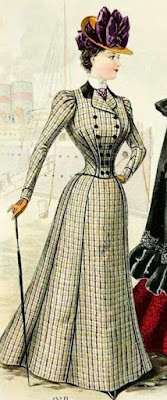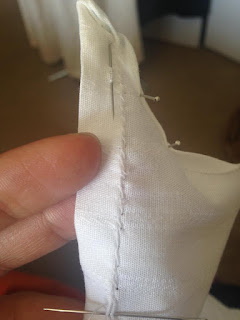1770's Yellow Woolen Caraco/ Prelude To Immersion Weekend
Disclaimer: Due to the nature of this blog entry, I do warn that there will be some out of date terms that are not exactly politically correct. If you are uncomfortable, please understand that these were words used throughout the 18th-20th century to define a group of people, and does not reflect my views or beliefs.
This weekend coming, I will be participating in an experiment at Historic Londontown & Gardens in Edgewater, MD. It is a full on immersion where several reenactors come from all over and do a living history immersion of what the Annapolis area was like in 1770. We will be really roughing it-eating authentic 18th century food, huddling together at night to keep warm by the fire, no electricity, no modern day comforts, and fully portraying our roles/ characters. With that said, I am portraying a young enslaved woman named Beck, who worked for the Fergusons (a very prominent family who lived and worked in Londontown). While there are no real accounts to Beck's physical description other than that she was described in the Ferguson's inventory schedule as a "negro woman...aged 22 years", I was able to learn that she was a member of a family of 4, and was held at a high value of 55 English pounds ($75.53 USD).
During my research, I decided to take another approach. What would she have worn if she were a servant to a tailor and stay maker? what would her cultural background have been? Was she a first or second generation African, or African-American? There were so many questions-so I had to improvise on what I already knew about her, and what I knew about fashion in the colonial era and what was mostly common for enslaved and freed blacks to wear. In addition to that I had to prepare myself mentally and emotionally for this delicate portrayal (more on that later).
I will not lie, construction with this outfit was HARD! Not because it was a wool jacket-as I've already created one a month prior, but because the wool jacket I had made prior was inaccurate for this event; I'm normally used to 1776-1780 fashion and this was to be a late 1760's jacket, so this was sort of uncharted waters for me. Thankfully I had some help from a friend who had plenty of period fabric available, and a copy of "Costume Close Up" for reference and of course my favorite patterns I frequently use. For starters, I had to lengthen it to a caraco length (2-3 inches longer than the pattern normally calls for.) and then sew like the wind. Once I had the jacket completed, I started on the headwrap/headscarf or Tignon that most enslaved and freed women wore (18th-19th century). While I am not sure what type of fabric the headscarf is (it was donated to me), it was long and wide enough to wrap and secure my hair.
Perhaps later, I may include eyelets in the jacket and run some red ribbon overtop of the stomacher, and even write up a first hand account of my experience during the winter immersion weekend (I really am considering) but for now. More prepwork, more sewing, more research before the weekend!
 |
| My little mascot just loves to be around fabrics <3 |



.jpg)


Comments
Post a Comment